7 Things I Learned In My Last Renovation and Subdivision Deal

I recently finished one of my latest subdivision and renovation deals, which was a four-bedroom house and a two-bedroom unit. They were on a single title joined by a common wall. When I purchased this property it was tenanted, but the leases were close to expiry.
We’re planning to hold these properties, so I’ve just recently had them valued by the bank, in preparation for my next deal. As I was waiting to hear back from the bank, I decided to reflect upon and share seven key things that I learned over the last 24 months of implementing this deal. I also contemplated how our approach differed from doing a quick flip renovation, which we have done previously on a number of occasions.
Here’s a photo of the property before we began the subdivision:
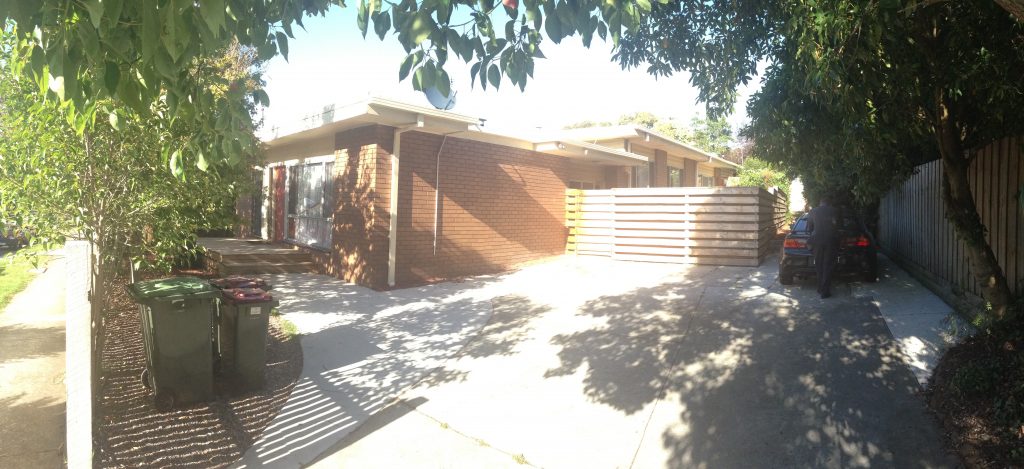
1. The Differences Between Renovating to Sell and Renovating to Hold
My favorite investing strategy is a quick flip renovation to immediately sell and move on; however a good investor is able to adapt based on the current market conditions. Due to the location of this property and the price it was purchased at, the potential for capital growth and attracting quality tenants was high; therefore, I quickly realized I had to adjust my thinking and consider the possibility of using a buy and hold approach.
My strategy was to hold this property as long as I could to leverage the strong capital growth and high rental return. I spent every cent on lifting the rental yield, and also to attend to maintenance issues that had the potential to cause long-term damage to the property, since having a high rental return immediately has as positive impact on the property value.
To understand the likely rental return on a property, my first stop was the local real estate agent – one with a large rental management portfolio. They were able to quickly advise me on what the average rental return was on various property sizes, and also the things that tenants want.
This focused my attention on where I needed to spend my funds to maximise my rental return. The items identified were those that would make the tenant’s lives easier, such as a dishwasher, as well as heating and cooling. Because I was aiming for a maximum yield and retention of tenants, a clean interior and a fresh paint job was essential.
If I was renovating to sell, I would’ve concentrated on ensuring the street appeal was maximised and the first impressions were the best. This means the entry into the house, and the quality of the surfaces fittings and appliances would be higher in order to be consistent with the surrounding blue chip area.
2. The Challenges of Taking Over Existing Rental Property and Renovating to Add Value
Here are before and after photos of the shower:
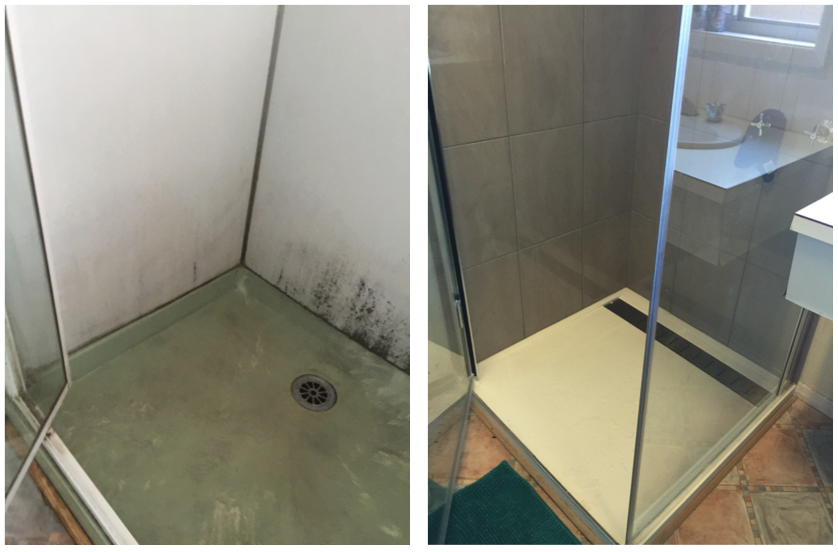
A big challenge when subdividing and renovating this property was maintaining cash flow by having the property tenanted whilst doing the subdivision. As your portfolio grows, managing cash flow becomes important, because you are relying on income derived from the property. As tenants expect and legally have a right to “quiet enjoyment” of their property, I had to have strategies in place to manage the project with that in mind. This particular property had long term tenants with young families, so it was extra-important to look after them during the renovation.
As our renovations included repainting the bathroom areas, which suffered from mould – a potential health issue – and fixing leaky toilets, we removed existing frustrations and problems. Whilst these may not have added instant value, I showed the tenants I cared about their experience while living in our property. This built loyalty, increased retention of the tenants for longer periods, and also made them more tolerant of the external work that had to take place.
This is a double-edged sword, because the tenant’s expectations of the speed the issues are attended to increases, especially if the issues don’t impact their ability to enjoy the property. They are also more likely to get disgruntled quicker if things aren’t completed in a timely manner.
3. The Importance of Having the Right Insurance Policy
As an investor, my time is valuable. Having the right insurance policy and insurance broker made what could have been a costly and time consuming event stress free. In the middle of the subdivision process, our front retaining wall, fence and landscaping was destroyed by flash flooding, causing thousands of dollars of damage. Here’s a photo of the damage:
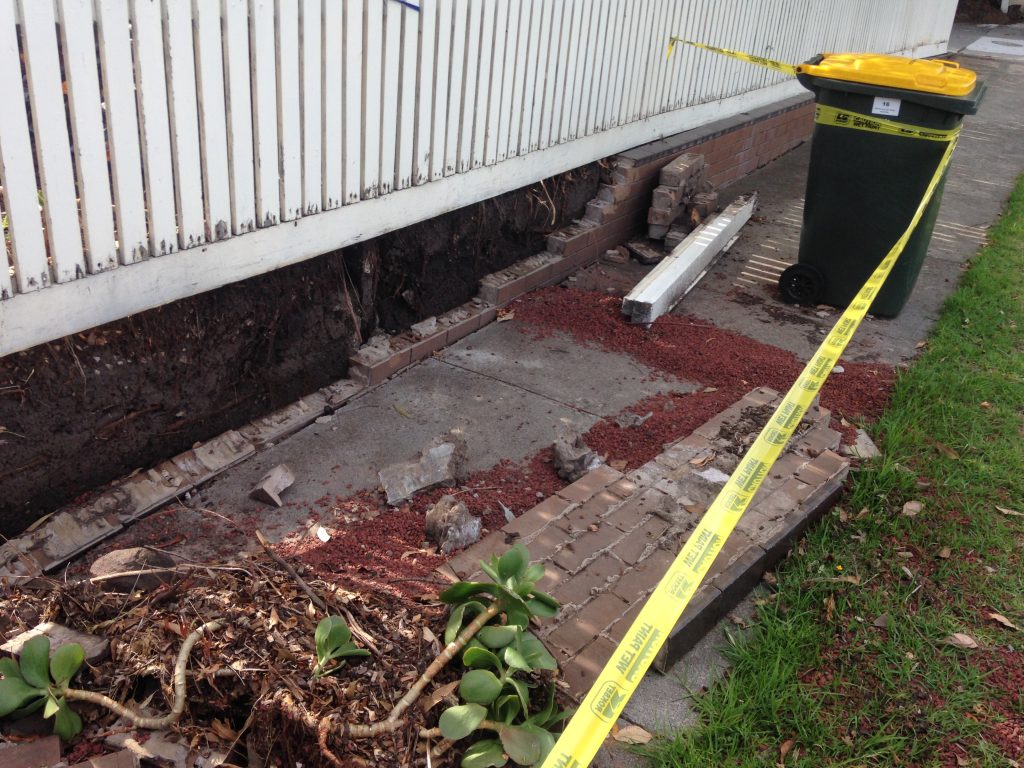
Insuring your investment property, especially when you are planning to manufacture profit and have a set budget for improvement works, is a critical aspect of your strategy. In the past, we used bulk insurers without understanding the details of the policy. For this property, we decided to use an insurance broker we recently met and were impressed with, and the results literally saved us thousands of dollars.
I would highly recommend all investors find an experienced broker who can design a policy that suits your project. A skilled insurance broker should be able to make sure you have the right policy coverage to cover common situations. Our policy included damage to the front fence from flowing water, which many policies don’t; therefore, whilst on holiday in Queensland, our broker took care of securing the property, allowing us to finish off our holiday in peace.
Not only did the insurance fully cover the works, we got a brand new retaining wall, fence and front yard, which instantly added to the street appeal and value of the property.
4. How to Project Manage the Renovation
When doing a quick flip, I am used to actively project managing, which is essential in order to control both time and budget concerns. As this project was a buy and hold, I let the rental manager do things I would normally do, as it saved me time and was easier. I learnt that actively managing your renovation is even more important when it is a rental.
Although it is tempting to use a rental manager to arrange for minor renovations and improvements, I found they don’t manage the quality of the works properly, because they are spending your money and have no skin in the game. Once something was done wrong; it was up to me to fix it.
My learning was to inspect the works myself because the agent was not thorough. Allowing the agent to inspect the works meant having critical details overlooked, such as a shower frame installed upside down and blinds installed in wrong rooms, so beware, and be sure to carry out your own inspections. Here’s a photo I took during one inspection:
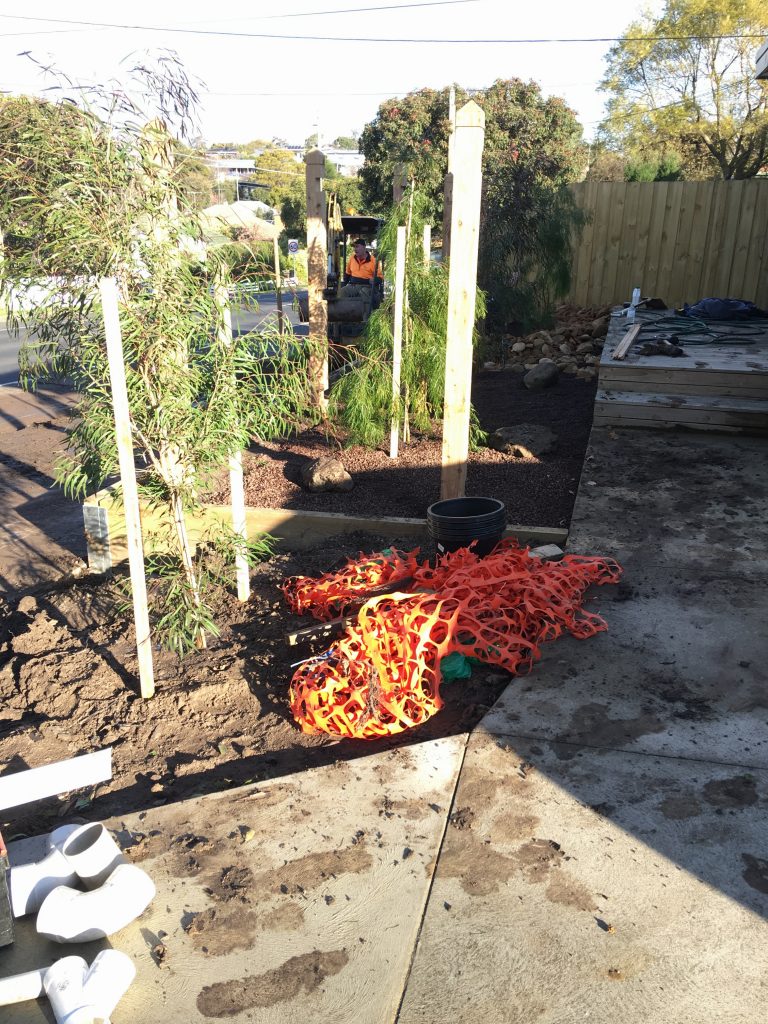
Often skilled tradesmen who are keen to get the job going may overlook critical advice relating to permit and regulatory requirements. Eager to rebuild our destroyed retaining wall and fence, we overlooked the fact that building on a property boundary automatically triggers a building permit, regardless of whether it’s replacing an existing structure or the height of a retaining wall.
We found this out after the wall was built when council hit us with a building notice, which meant we had to get an engineer to certify that the wall was built properly – an expensive and time consuming exercise.
Make sure you obtain qualified advice from a building surveyor when building anything. Generally, building surveyors are happy to provide advice prior to commencing on improvements at little cost to you.
5. The Challenges of Subdividing With a Tenant in the Property
Subdivisions generally involve excavation, heavy machinery on site, disruption to utilities, dust and noise, which had the potential to cause our tenants hassles and generally making them unhappy. Maintaining a good relationship with our tenants was crucial. I achieved this by making sure they were well briefed with plenty of notice and I provided them with options to escape during the most disruptive periods of the project. This way, they felt included in the process and not trapped.
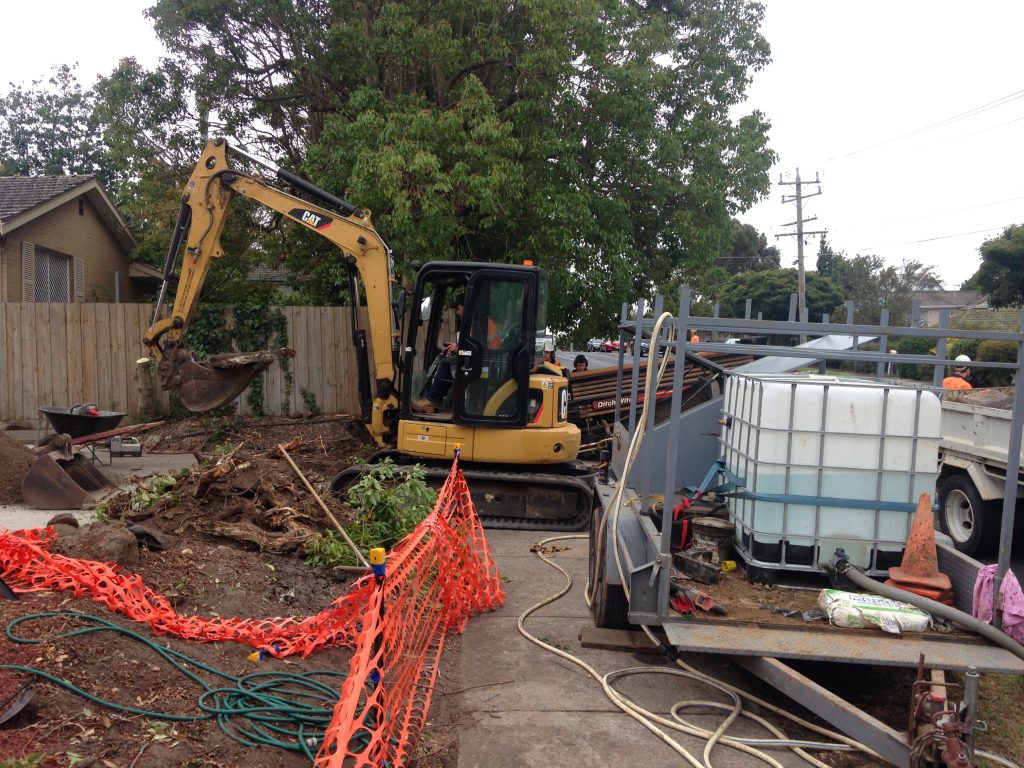
In our case, we had to occupy the driveway for over a week and had heavy machinery working inside the property for several days, as you can see in the above image. We employed several strategies to ensure disruption to the tenants was minimised. This included:
- Sharing our vision and plans for the property with our tenants.
- Accurate regular and timely updates on the duration and nature of works taking place.
- Ensuring the contractors accessing the site understood they were tenanted, they were not permitted to enter unless notification had been given. They also had to make their presence known if the tenants were at home.
- Ensuring contractors restricted access to no-go zones during construction to maintain a safe worksite.
The project required the installation of a water main, as well as electrical conduits along the length of the driveway. This meant we potentially had to excavate a trench along the only access point to the rear of the property. To minimise disruption, we decided to use a method that allowed installing a conduit for water and power under the driveway without resorting to excavating.
Doing this and not having to build the access to the rear unit not only reduced our costs, but meant access to the rear unit was maintained for the tenants, reducing the impact on them. So, while on a per meter basis using a directional bore to install the conduits was more expensive then digging a trench, other costs, such as having to rebuild the access to the rear and disrupting the tenants meant we ended up saving in the long run, reducing the construction time and keeping our tenants happy.
Having happy and understanding tenants did help, but I never took that for granted when managing the subdivision.
6. How to Achieve Above Market Rental Yield by Adding Value for the Tenants
Applying the learnings from Steve McKnight, I implemented creative strategies to increase yield, such as asking the tenants what would make them more comfortable. I remember the meeting well as I watched the rental manager squirm when I asked this question. The rental manager also advised us not to increase the rent because they were concerned we would lose tenants.
I always ask the tenants myself, rather than through the rental manager, as I think it is helpful to show interest in them as my tenants and also about my property. Our tenants were more than happy to pay $15 dollars extra per week to get a split system air conditioner to cool them down during the summer. They saw value in this, and so did I, as it meant they were likely to stay on longer as tenants. It also added value to my property by increasing the rental yield.
This is just one simple strategy that you can apply.
7. How to Design the Subdivision to Achieve Maximum Return in the Future and Creating Buyer Appeal
Here’s a photo I took after the subdivision and renovation was complete:
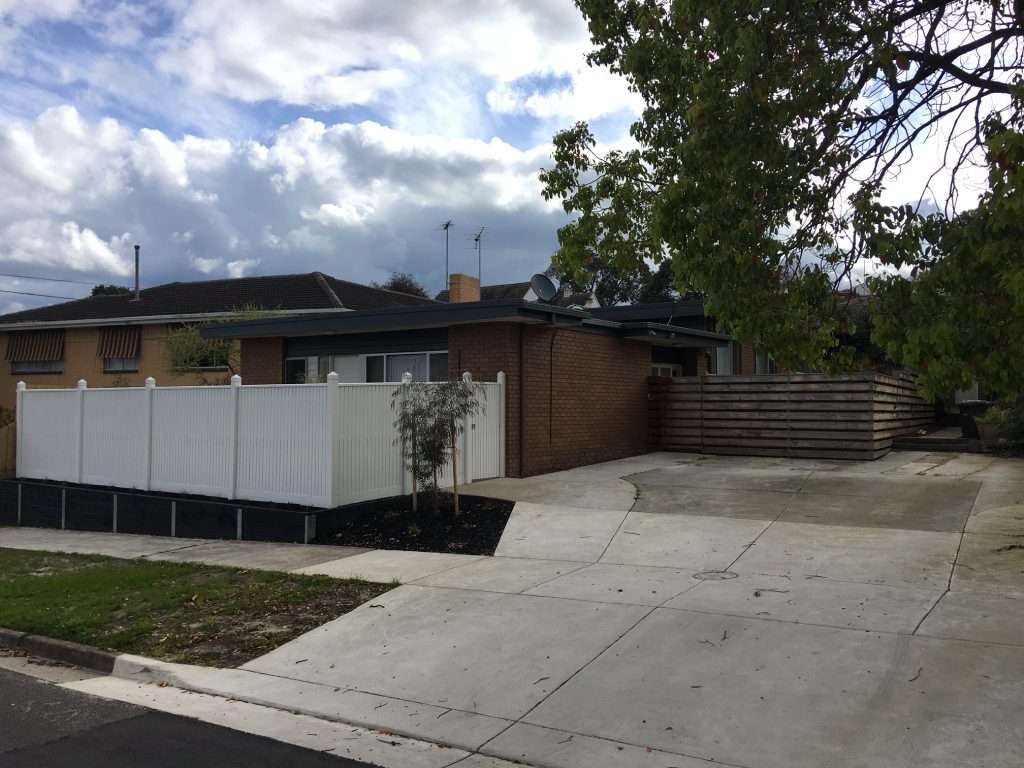
Although my strategy with this property is to buy and hold, I may sell this property in the future. In that case, I want the best return possible and with that in mind, I did my research on what would create maximum appeal for buyers.
Some of the important items for buyers I identified are privacy, security and independent titles. In the context of two small subdivided units, addressing these can mean getting premium price or not. When I established there was potential to subdivide the property, we looked at how we could achieve a good outcome by thinking about these three items in particular.
We had two options in the design of the subdivision; one was to have a common area for parking, which would have meant having common land, a body corporate, and everything else that goes along with that. We were able to design the subdivision, so that each property was on an independent title. Whilst common land is quite common in subdivided blocks, we wanted to create the best possible return in the future. It took a bit more effort to design the subdivision this way, but it was worth it.
Conclusion
In the 18 months after settlement, we have a four-bedroom house and a two-bedroom unit with a common wall on separate and independent titles, with scope to manufacture profit from renovation to further increase the rental yield.
This includes a positive cash flow of $6,000 per year and additional manufactured equity of $100,000 based on a bank valuation.
You know you are onto a good thing when the agent who sold you the property calls and advises you to hold on to it as long as you can.





Got something to say? Post a comment...
You must be logged in to post a comment.